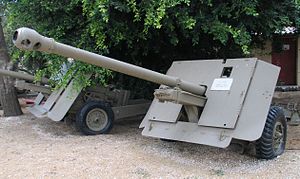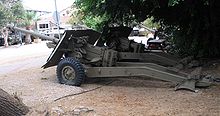Ordnance QF 17-pounder
This article needs additional citations for verification. (April 2008) |
| Ordnance QF 17 pounder | |
|---|---|
 17-pounder in Batey ha-Osef museum, Israel | |
| Type | anti-tank gun |
| Place of origin | |
| Service history | |
| In service | 1943 - |
| Wars | World War II, Korean War |
| Production history | |
| Designed | 1941/42 |
| Produced | 1942- |
| Specifications | |
| Mass | 3 long tons |
| Calibre | 3 inches (76.2 mm) |
| Carriage | Split trail carriage, with gunshield. |
| Elevation | -6° to +16.5° |
| Traverse | 60° |
| Muzzle velocity | 3,950 feet per second (1,204 m/s) APDS |
The Ordnance QF 17-pounder (or just 17-pdr) was a 76.2 mm (3 inch) gun developed by the United Kingdom during World War II. It was used as an anti-tank gun on its own carriage, as well as equipping a number of British tanks. It was the most effective Allied anti-tank gun of the war. Used with the APDS shot it was capable of defeating all but the thickest armour on German tanks. It was used to 'up-gun' some foreign-built vehicles in British service, notably the Sherman Firefly that gave British tank units the ability to hold their own with their German counterparts. In the anti-tank role it was replaced by the 120 mm BAT recoilless rifle after the war. As a tank gun it was succeeded by the 20 pounder.
History

Although it had not yet entered service, the British predicted that the QF 6-pounder would soon be inadequate given the increasing armour of German tanks. In late 1940 a design effort was started to create a replacement, and the effort was largely complete by the end of 1941. A prototype production line was set up that spring, and with the appearance of Tiger tanks in North Africa, the first 100 prototype 17-pdr anti-tank guns were quickly sent off to help counter this new threat. So great was the rush that they were sent before proper carriages had been developed, and the guns had to be mounted in the carriages of 25-pounder gun-howitzers. These early weapons were known as 25/17-pounders and given the codename Pheasant. They first saw action in February 1943.
Fully developed 17-pdrs were placed into production in 1943 and were first used during the Italian Campaign. In about September 1944, the British started to use APDS shot for the 17-pdr, which travelling at over 1,200 metres per second increased the armour penetrating power of the 17-pdr greatly with a penetration of 140 mm armour over 1,000 yards (910 m). The disadvantages of APDS as compared with the 17-pdr's regular APCBC ammunition was that it was much less accurate and did not do nearly as much damage to an enemy tank if it did penetrate. APDS shot remained rare accounting for only about 6% of the average loadout of a 17-pdr equipped British tank.
Initially the HE shell that was developed for the 17-pdr lacked power. This was due to the high powered cartridge - the shell walls had to be thicker to stand the stresses of firing leaving less room for explosive. Reducing the size of the propelling charge for the HE shell allowed the use of a thinner walled and more explosive shell.
The 17-pdr was a much bulkier and heavier weapon than its predecessor. As a result it had to be towed as it could not effectively be moved by its crew alone and needed vehicles (such as the Crusader gun tractor) on poor ground and was issued strictly to armour and anti-tank artillery units, and not infantry. The other disadvantage of the 17-pdr was the very large muzzle flash when it was fired, due to the large amount of propellant in its cartridges.

The gun was also quickly adapted for use on various tank chassis, outperforming everything the US or British had. Early attempts to mount it on existing British chassis were not successful, but the British were able to very quickly devise a conversion for their US supplied M4 Sherman tanks and it was rushed into service in time for D-Day as the Sherman Firefly. So as to fit into the turret of the Sherman the gun had to be rotated through 90 degrees, ie it lay on its side, and an additional box was welded to the back of the turret to allow for the recoil. The British also converted some of their US produced M10 Wolverine self-propelled guns removing the 3-inch (76 mm) cannon and replaced it with the 17-pdr as well; the resulting vehicles were called Achilles or just 17 pdr M10. The 17-pdr was also successfully fitted to the Australian-designed Sentinel tank during trials, though no Sentinels equipped with this gun entered service with the Australian Army.
The 17 pounder anti-tank guns saw action in Korea, not only against tanks but in general support use against bunker positions.
United States use
The United States Army did not use the 17-pounder in action, although the gun was offered to US forces, with a number of Shermans modified for testing [1]. US pre-war doctrine was based on using tanks in the infantry-support and exploitation roles, avoiding combat with enemy tanks whenever possible. The role of fighting enemy tanks was given to the tank destroyers. Thus the US M4 Sherman mounted much smaller 75 mm weapons, leaving the 3in-armed M10 Wolverine to deal with German armour. In practice this doctrine proved flawed. The smaller guns and lighter armour of US tanks proved to be a serious disadvantage when they ran into German tanks such as the Panther.
The British success with the 17 pounder did not go unnoticed.[citation needed] In the spring of 1944, Shermans with the new 76 mm gun M1 entered production, with about 100 available in the UK prior to D-Day. The first 76 mm-armed tanks saw combat during Operation Cobra and became common by the winter. Although the US 76 mm was considerably less powerful than the British 17-pounder when firing the most common APC ammunition, when firing HVAP ammunition its performance was adequate against most German armour, though this ammunition was in very short supply for tank use. The 17-pounder, however, remained the best Allied AT gun.
Variants
- Mark I
- first production versions.
- Mark II
- intended for tank use. Removed the carrier mountings and replaced the muzzle brake with a counterweight. The brake was added back on in March 1944 with the introduction of the APDS shot. The Mk. II was used on the Archer tank destroyer and Challenger tank.
- Mark III
- Royal Navy adaptation for use on landing craft, generally similar to the Mk. I, but included an automatic loading system. Unused.
- Mark IV
- Another tank adaptation, this time with a different breech where the block slid to the side instead of down to take up less room. Unused.
- Mark V
- A version of the Mk IV with different mounts to allow it to replace the US 3in (76.2mm) Gun M7 on the 3in SP, Wolverines, creating the 17pdr SP Achilles.
- Mark VI
- Another Mk. IV adaptation with a shortened breech.
- Mark VII
- Similar to the Mk. VI, yet another change to the breech.
77 mm HV
- As the breech-length of the 17-pdr was too long to fit in many tanks a new version was designed with a shorter breech, firing the same projectile as the 17-pdr from a 3-inch 20 cwt AA gun cartridge, along a shortened 17-pdr barrel. This new gun's ammunition was not interchangeable with the 17-pounder, so to prevent confusion over ammunition supplies, it was renamed the "77 mm HV" - the 'HV' standing for High Velocity - even though it was the same 76.2 mm calibre as the 17-pdr. This gun was used in the Comet tank.
Usage
Anti-tank gun
- 25 pdr carriage
Stop gap measure named Pheasant.
- Split trail carriage
- Split trail carriage, with gunshield.
- Weight: 3 t.
- Elevation: -6° to +16.5°
- Traverse: 60°
Vehicle mount
- World War II
- Tank, Cruiser, Challenger (A30)
- SP 17pdr, A30 (Avenger)
- Tank, Cruiser, Comet I (A34) (77 mm OQF HV)
- SP 17pdr, Valentine, Mk I, Archer tank destroyer built from Valentine tank hull.
- Sherman Firefly (Modified Medium Tank M4)
- 17pdr SP Achilles (Modified 3in SP, Wolverine)
- Tank, Infantry, Black Prince (A43) (prototype tank, never fielded)
- Australian Cruiser tank Mk IV (prototype turret only, never fielded)
- Post-war
Notes
References
External links
- LemaireSoft
- Nase noviny
- Images of 17 pounder at Singleton Infantry Museum
- A guide to tracked British 17 pounders
- Armor penetration table
- 17 Pounder development, production and ammunition data
